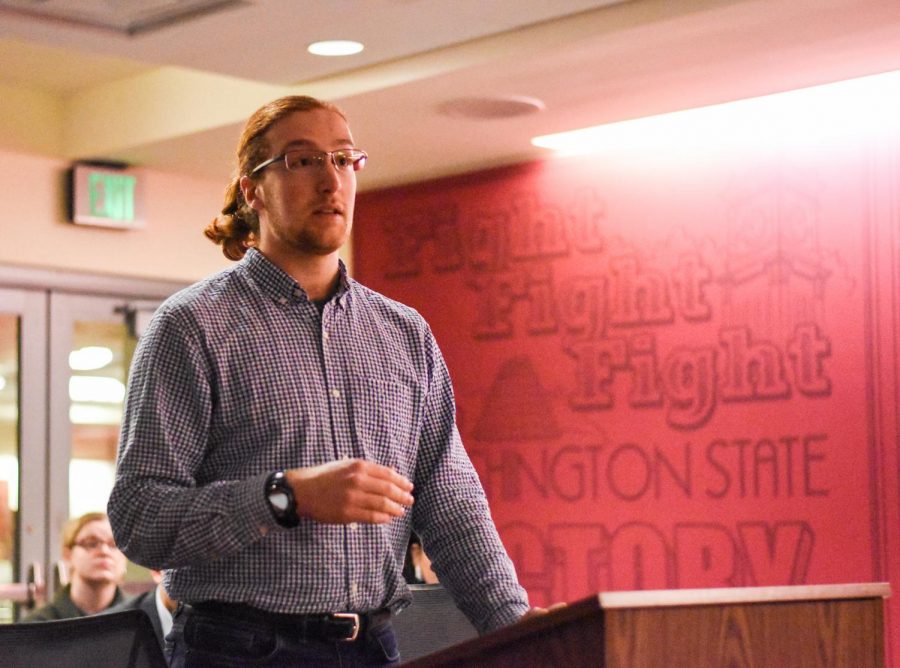Resolution for removal of dams fails to pass
Legislation does not get two-thirds majority vote from ASWSU Senate
Environmental Sustainability Chair Patrick Robichaud discusses the benefits of the removal of the Snake River dams for salmon in the state of Washington.
November 21, 2019
A resolution calling for the removal of four lower Snake River dams did not pass during the ASWSU Senate meeting on Wednesday.
The resolution failed to reach a two-thirds majority vote. It called for the removal of the Ice Harbor, Lower Monumental, Little Goose and Lower Granite dams.
Environmental Sustainability Chair Patrick Robichaud testified to the Senate for the approval of the resolution. He said the removal of the dams would prevent the extinction of the salmon population in the region.
“These dams have been a continual fight between environmentalists and proponents of them since their inception since the ’70s,” he said.
Senator Mikaela McCoy notified the Senate of the feedback she received from her College of Agricultural, Human, and Natural Resource Sciences constituents.
She said students and faculty at the college were worried about the effects the removal of the dams would have on farmers and the agriculture in the region.
The only economically viable way that grain is brought into the area is through the river, she said. The dams allow for shipments to be brought in.
“It would be billions of dollars to breach the dams,” McCoy said. “Wind is not economically sound. Coal is bad. Solar—you can’t use at night.”
Robichaud said power needs in the region could be met with other renewable forms of energy as the U.S. has become more energy efficient.
“You don’t need to produce that much power to replace these dams,” he said. “I had heard that if these dams were to power the city of Seattle, it would not have enough power to do so.”
McCoy said the faculty at the college were worried CAHNRS donors would pull out funding if the resolution was passed. The dams power about 800,000 homes in the area, she said.
Senator Linda Vargas said the salmon population is beneficial to Native American populations in the area.
She read a letter signed by Native American tribes calling for support of the resolution to Senate members. Representatives from the Puyallup, Tulalip, Colville Confederated, Navajo, and Yakama tribes signed the letter.
Senator Jocelyn Granados said she supported the resolution for its benefits to salmon populations and Native American cultures.
“We’ve seen it time and again,” she said. “Indigenous people have been ignored, land stolen, things like that, and this is why I am in favor of this resolution.
Joshua Hiler, sophomore political science major, said the loss of hydropower would likely increase the amount of power produced from sources like coal, natural gas and nuclear energy.
“[Coal and natural gas] generate a significant amount of carbon pollution, and the other is politically unviable for a number of reasons,” he said.
He said the long-term ecological impacts would be significantly worse for local ecology and the entire planet.
The Senate also passed a bill that requires the election board to hold at least two presidential debates during election season.
Ryan Vance, a third-year political science, Chinese and Japanese major, was also confirmed as the deputy director of legislative affairs.











Roger Trump • Nov 25, 2019 at 9:29 am
1 add more Salmon hatcheries 2 add hatcheries at mouth of the Columbia River 3 increase breeding of Salmon to increase fat content
Eric S Prater • Nov 22, 2019 at 11:37 am
Climatologists and renewables, peas in a pod. What climas don’t tell you is that China is RAPING the environment for cheap solar panels, where is the Chinese EPA? Oh there is none, so cheap solar is a myth, when the environmental bill comes due, it’s going to hurt. What happens when The sun goes down? Solve it please, that cost goes on top of those environment RAPING solar panels from China, please include the carbon footprint of shipping them from the other side of the world. Everything shipped has a carbon footprint. Barging wheat and other cmmodities has less of a carbon footprint then inefficient trucks, what happens when the wind stops, as it did for 7 days in November,zero, zilch, nada renewable, climatologist loving, Save the world wind power. How big will the solar farm be? How many cheap environment RAPING cheap Chiese solar panels will be used? I know how many square miles of land used will be for residential power. So many questions so few climatologist answers!
Chris Pfohl • Nov 21, 2019 at 1:14 pm
There may be nuclear and other viable generating solutions available in the near future.
Fusion reaction research, while scorned as the power source of the future and always will be…, has actually made significant gains over the years – equal in progress to the microchip but you can’t display those advances until you have reached a functional product.
Additionally there is Gate’s program called TerraPower which is fueled by nuclear waste and low halflife material in an autonomous subgrade mini reactor. Additionally, advances in solar, wind, and storage systems which add flexibility to the grid are constant.